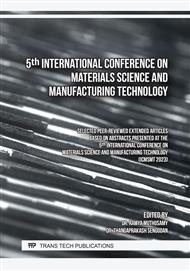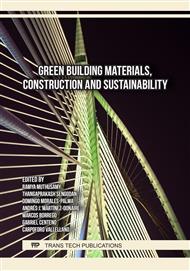[1]
Alaa, M. R., Dina, M. S., Hassan, A. H. An investigation on blast-furnace stag as fine aggregate in alkali activated slag mortars subjected to elevated temperatures. Journal of Cleaner Production. 2016. 112. Pp.1086-1096
DOI: 10.1016/j.jclepro.2015.07.127
Google Scholar
[2]
Semiha, A. and Cuneyt, U. Recycling of waste PET granules as aggregate in alkali-activated blast furnace slag/metakaolin blends. Construction and Building Materials. 2014. 58. Pp.31–37
DOI: 10.1016/j.conbuildmat.2014.02.011
Google Scholar
[3]
Ahmed, A. M., Hui, S., Yasser, K. Characteristics of self-consolidating concrete with RAP and SCM. Construction and Building Materials. 2016. 102. Pp. 564–573
DOI: 10.1016/j.conbuildmat.2015.11.007
Google Scholar
[4]
Ankur, M., Rafat, S., Togay, O., Faiz, U. A. S., Rafik, B. Fly ash and ground granulated blast furnace slag-based alkali-activated concrete: Mechanical, transport and microstructural properties. Construction and Building Materials. 2020. 257. Pp. 119-548
DOI: 10.1016/j.conbuildmat.2020.119548
Google Scholar
[5]
Adithya, T., Gopinatha, N., Muralidhar, K. Adithya, S., Kiran, K. S. Utilization of cashew nut-shell ash as a cementitious material for the development of reclaimed asphalt pavement incorporated self compacting concrete. Construction and Building Materials.2021. 301 Pp. 124197
DOI: 10.1016/j.conbuildmat.2021.124197
Google Scholar
[6]
Subhash, C. Y., B. Chethan, K., Krishna, M. Optimization of ferrocchrome slag as coarse aggregate in concretes. Computers and concrete. 2019 23(6)
Google Scholar
[7]
Ghasan, F. H., Abdul, R. M. S., Rayed, A. Texture, morphology and strength performance of self-compacting alkali-activated concrete: Role of fly ash as GBFS replacement. Construction and Building Materials. 2020
DOI: 10.1016/j.conbuildmat.2020.121368
Google Scholar
[8]
Ghasan, F. H. and Kwok, W. S. Durability and life cycle evaluation of self-compacting concrete containing fly ash as GBFS replacement with alkali activation. Construction and Building Materials. 2020. 235. Pp.117458
DOI: 10.1016/j.conbuildmat.2019.117458
Google Scholar
[9]
Guneet, S. and Uthej, V. Assessing properties of alkali activated GGBS based self-compacting geopolymer concrete using nano-silica. Case Studies in Construction Materials. 2020. 12. Pp. 003-52
DOI: 10.1016/j.cscm.2020.e00352
Google Scholar
[10]
Mehmet, E. G., Radhwan, A., Ayad, A. R., Anil, N., Ahmet, E. K. Development of fly ash/slag based self-compacting geopolymer concrete using nano-silica and steel fiber. Construction and Building Materials. 2019. 211. Pp. 271–283
DOI: 10.1016/j.conbuildmat.2019.03.228
Google Scholar
[11]
Ghasan, F. H., Abdul, R. M. S., Kwok, W. S., Jahangir, M. Effects of ceramic tile powder waste on properties of self-compacted alkali-activated concrete. Construction and Building Materials. 2020. 236 Pp. 117574
DOI: 10.1016/j.conbuildmat.2019.117574
Google Scholar
[12]
Savas, E. and Marva, A. B. Environmental performance and mechanical analysis of concrete containing recycled asphalt pavement (RAP) and waste precast concrete as aggregate. Journal of Hazardous Materials. 2014. 264. Pp.403– 410
DOI: 10.1016/j.jhazmat.2013.11.040
Google Scholar
[13]
Nitendra, P., A. U. Ravi, S., B. M. Mithun. Durability studies on eco-friendly concrete mixes incorporating steel slag as coarse aggregates. Journal of Cleaner Production. 2016. 129. Pp. 437-448
DOI: 10.1016/j.jclepro.2016.04.033
Google Scholar
[14]
Mithun, B. M. and Narasimhan, M. C. Performance of alkali activated slag concrete mixes incorporating copper slag as fine aggregate. Journal of Cleaner Production. 2015, Pp. 1-8
DOI: 10.1016/j.jclepro.2015.06.026
Google Scholar
[15]
Surender, S., G.D. Ransinchung, Praveen, K. Effect of mineral admixtures on fresh, mechanical and durability properties of RAP inclusive concrete. Construction and Building Materials. 2017. 156. Pp. 19–27
DOI: 10.1016/j.conbuildmat.2017.08.144
Google Scholar
[16]
Manjunath, R. and Mattur, C. N. An experimental investigation on self-compacting alkali activated slag concrete mixes. Journal of Building Engineering. 2018. 17. Pp. 1–12
DOI: 10.1016/j.jobe.2018.01.009
Google Scholar
[17]
Parthiben, K. and Saravana, R. M. J. Influence of recycled concrete aggregates on the flexural properties of reinforced alkali activated slag concrete. Construction and Building Materials. 2016. 102. Pp. 51–58
DOI: 10.1016/j.conbuildmat.2015.10.148
Google Scholar
[18]
Najat, A., Benjamin, V., Richard, H. Alkali-activated slag characterization by scanning electron microscopy, Xray microanalysis and nuclear magnetic resonance spectroscopy. Materials Characterization. 2020. 168 Pp. 110-504
DOI: 10.1016/j.matchar.2020.110504
Google Scholar
[19]
Zengqing, S., Xiaochen, L., Zijan, S. Synthesis of alkali activated slag-asphalt emulsion composite. Construction and Building Materials. 2020. 263. Pp. 120-256
DOI: 10.1016/j.conbuildmat.2020.120256
Google Scholar
[20]
Xianyu, Z., Yusheng, Z., Pang, C. Zhenzhen, J, Wenzhing, Z. Mechanical properties of basalt and polypropylene fibre-reinforced alkali-activated slag concrete. Construction and Building Materials. 2020
DOI: 10.1016/j.conbuildmat.2020.120256
Google Scholar
[21]
Md. Nabi, N. K., Ashish, K. S., Prabir, K. S. Evaluation of the ASR of waste glass fine aggregate in alkali activated concrete by concrete prism tests. Construction and Building Materials. 2021. 266 Pp. 121-121
DOI: 10.1016/j.conbuildmat.2020.121121
Google Scholar
[22]
Zhenming, L., Tianshi, L., Yun, C., Bei, W., Guang, Y. Prediction of the autogenous shrinkage and microcracking of alkali-activated slag and fly ash concrete. Cement and Concrete Composites. 2021. 117 Pp. 103-913
DOI: 10.1016/j.cemconcomp.2020.103913
Google Scholar
[23]
Arivalagan, S. and Sethuraman, V. S. Experimental study on the mechanical properties of concrete by partial replacement of glass powder as fine aggregate: An environmental friendly approach. Materials Today: Proceedings. 2020
DOI: 10.1016/j.matpr.2020.09.722
Google Scholar
[24]
Katja, K., Katja, T., Majda, P., Vilma, D. Evaluation of locally available amorphous waste materials as a source for alternative alkali activators. Ceramics International. 2021. 47 Pp. 4864–4873
DOI: 10.1016/j.ceramint.2020.10.059
Google Scholar
[25]
Guohao, F. and Mingzhong, Z. The evolution of interfacial transition zone in alkali-activated fly ash-slag concrete. Cement and Concrete Research. 2020. 129. Pp. 105963
DOI: 10.1016/j.cemconres.2019.105963
Google Scholar
[26]
Kitipong, R., Thippakorn, U., Tawich, P., Weerachart, T., Chai, J. Mechanical properties, shrinkage, and heat evolution of alkali activated fly ash concrete. Construction and Building Materials. 2021. 299. Pp. 123954
DOI: 10.1016/j.conbuildmat.2021.123954
Google Scholar
[27]
Atul, G., Dhirendra, S., Parveen. Review on the durability properties of sustainable alkali activated concrete. Materials Today: Proceedings. 2020
DOI: 10.1016/j.matpr.2020.06.370
Google Scholar
[28]
Ganta, M., Baskar, R., J. S. Kalyana, R. Experimental investigation on physical and mechanical properties of alkali activated concrete using industrial and agro waste. Materials Today: Proceedings. 2020
DOI: 10.1016/j.matpr.2020.07.634
Google Scholar
[29]
Meysam, N. and Nader, G. Engineering properties of natural pozzolan/slag based alkali-activated concrete. Construction and Building Materials. 2019. 208. Pp. 46–62
DOI: 10.1016/j.conbuildmat.2019.02.107
Google Scholar
[30]
Guohao, F., Wing, K. H., Wenlin, T., Mingzhong, Z. Workability and mechanical properties of alkali-activated fly ash-slag concrete cured at ambient temperature. Construction and Building Materials. 2018. 172. Pp. 476–487
DOI: 10.1016/j.conbuildmat.2018.04.008
Google Scholar
[31]
Dongxing, X., Pei, T., Chi, S. P. MSWIBA-based cellular alkali-activated concrete incorporating waste glass powder. Cement and Concrete Composites. 2018
DOI: 10.1016/j.cemconcomp.2018.10.018
Google Scholar
[32]
Shutong, Y., Jinjin, X., Chaohui, Z., Rui, L., Qiubo, Y., Shuguang, S. Mechanical properties of alkali-activated slag concrete mixed by seawater and sea sand. Construction and Building Materials. 2019. 196. Pp. 395–410
DOI: 10.1016/j.conbuildmat.2018.11.113
Google Scholar
[33]
Guneet, S. and Uthej, V. Assessing properties of alkali activated GGBS based self-compacting geopolymer concrete using nano-silica. Case Studies in Construction Materials. 2020. 12. e00352
DOI: 10.1016/j.cscm.2020.e00352
Google Scholar
[34]
Chaitanya, S. T. and Gunneswara, R. Effect of mix design parameters on mechanical and durability properties of alkali activated slag concrete. Construction and Building Materials. 2018. 193. Pp.173–188
DOI: 10.1016/j.conbuildmat.2018.10.189
Google Scholar
[35]
Subhash, C. Y., B. Chethan, K., C. JITIN. Durability studies on ferrochrome slag as coarse aggregate in sustainable alkali activated slag/fly ash based concretes. Sustainable Materials and Technologies. 2019
DOI: 10.1016/j.susmat.2019.e00137
Google Scholar
[36]
Ali, A. A., Abd, E. M. A. E., Mohammed, A. E. Factors affecting the mechanical properties of alkali activated ground granulated blast furnace slag concrete. Construction and Building Materials. 2019. 197. Pp. 339–355
DOI: 10.1016/j.conbuildmat.2018.11.086
Google Scholar
[37]
Nabeel, A. F., M. Neaz, S., Muhammad, N. S. H. Investigation of engineering properties of normal and high strength fly ash based geopolymer and alkali-activated slag concrete compared to ordinary Portland cement concrete. Construction and Building Materials. 2019. 196. Pp. 26–42
DOI: 10.1016/j.conbuildmat.2018.11.083
Google Scholar
[38]
Puertas, F., B. Gonzalez, F., I. Gonzalez, T., M. M. Alonso, M. Torres, C., G. Rojo, F. Martinez, A. Alkali-activated slag concrete: Fresh and hardened behaviour. Cement and Concrete Composites. 2018. 85. Pp. 22-31
DOI: 10.1016/j.cemconcomp.2017.10.003
Google Scholar
[39]
Md Manjur, A. E., Md. Maruf, H., Md. Rezaul, K., Muhammad, F. M. Z., Christopher, S. A review on alkali-activated binders: Materials composition and fresh properties of concrete. Construction and Building Materials. 2020. 260. Pp. 119788
DOI: 10.1016/j.conbuildmat.2020.119788
Google Scholar
[40]
Athira, V. S., V. Charitha, G. Athira, A. Bahurudeen. Agro-waste ash based alkali-activated binder: Cleaner production of zero cement concrete for construction. Journal of Cleaner Production. 2021. 286. Pp.125429. DOI:
DOI: 10.1016/j.jclepro.2020.125429
Google Scholar
[41]
Xijun, S., Anol, M., Dan, Z. Sustainability assessment for Portland cement concrete pavement containing reclaimed asphalt pavement aggregates. Journal of Cleaner Production. 2018
DOI: 10.1016/j.jclepro.2018.05.004
Google Scholar
[42]
Nabil, H., Hima, K.S., Mothi, K. M., Arjun, H. R., Santhosh, G., Jorisa, C. Alkali-activated concrete paver blocks made with recycled asphalt pavement (RAP) aggregates. Case Studies in Construction Materials. 2019
DOI: 10.1016/j.cscm.2019.e00322
Google Scholar



